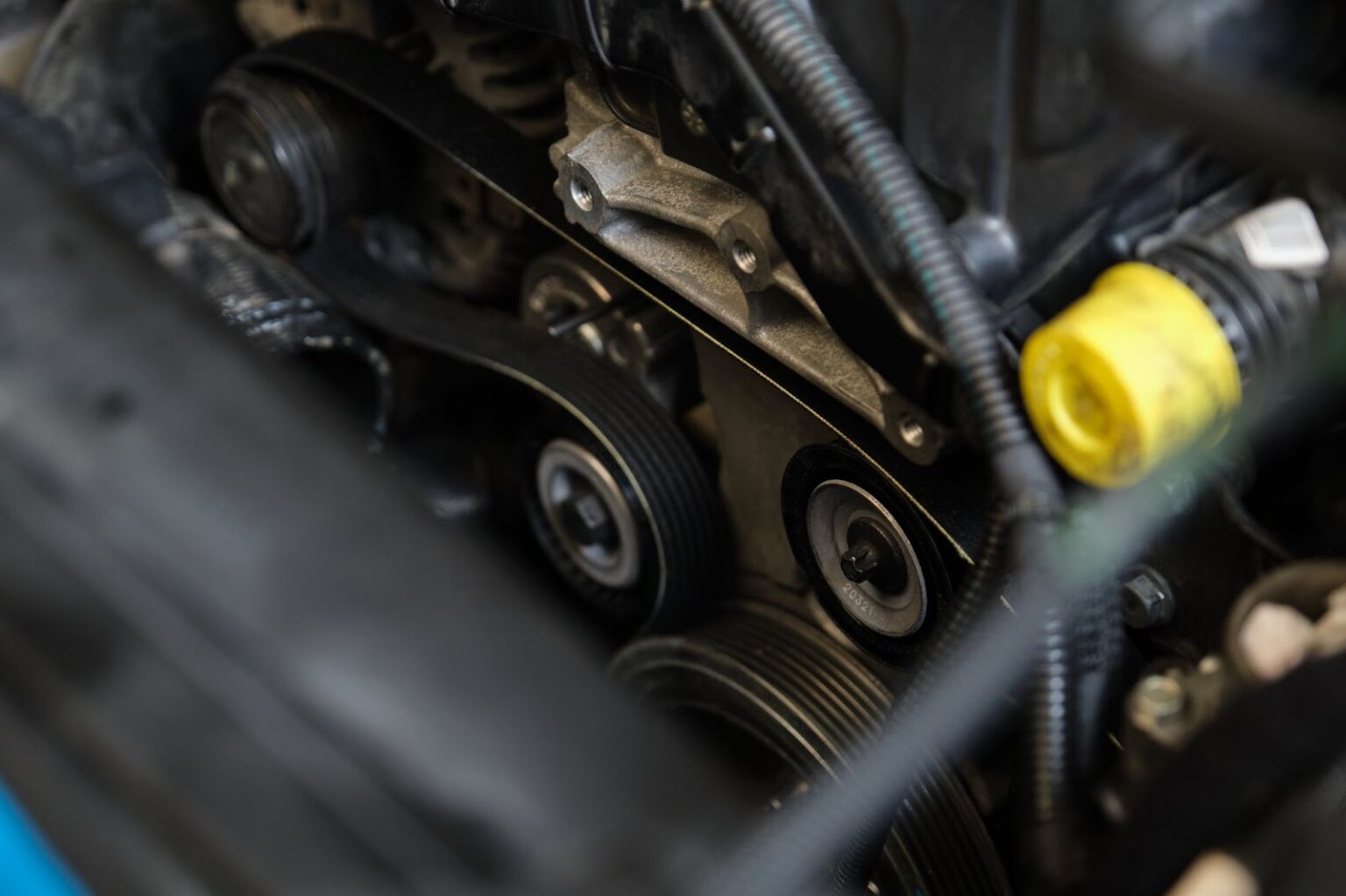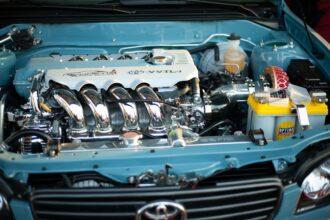You’re cruising along at 65 mph, music up, traffic light, when suddenly “bang!” the car lurches, the steering stiffens, and the engine goes dead silent. In that split second, your relaxing drive turns into a roadside nightmare.
What just happened? In many cases, it’s the dreaded timing belt break, and if you’re unlucky, the damage to your car’s engine could be severe enough to require a complete rebuild or even a new engine.
Whether you own a new car or an older model, if your car has a timing belt, understanding what happens when it fails can save you thousands in auto repair costs, and maybe even prevent serious damage before it’s too late.
What Is a Timing Belt and Why Is It Important?
A timing belt is a reinforced, toothed belt that aligns the rotation of the crankshaft and camshaft in your engine. This precise timing ensures the engine’s valves open and close at the correct intervals, allowing fuel and air into the cylinders and letting exhaust gases out.
Without this belt, the operation of the engine becomes chaotic, valves and pistons can collide, causing catastrophic engine damage.
How a Timing Belt Works?
When the engine is running, the belt keeps the pistons and valves moving in perfect harmony. The timing of the engine’s valves is crucial, if it’s off by even a fraction, you risk misfires, poor engine performance, or worse, damage to the engine.
Some vehicles use a timing chain or cam chain instead, which is made of metal and generally lasts longer, but timing belts are still common in many makes and model variations.
What Happens When Your Timing Belt Breaks?
When your timing belt breaks, the harmony inside your car’s engine is instantly lost. The belt no longer keeps the crankshaft and camshaft moving together, which means the engine’s valves and pistons can be out of position in milliseconds.
In an interference engine, this can be devastating; valves and pistons may collide, bending or breaking vital engine components and causing serious damage. Often, the repair bill is so high that a new engine or a used engine is the only option.
In a non-interference engine, a broken timing belt will still cause the car to break down immediately, but since the valves occupy the same space as pistons at different times, they won’t hit each other. You might get away with just a belt replacement, but you’ll still be stranded until it’s fixed.
Either way, a timing belt failure means you can’t drive the car until repairs are done, and delaying can lead to further damage to the engine.
Interference vs. Non-Interference Engines
The type of engine you have determines how bad the consequences will be if your timing belt breaks.
Interference Engine:
The valves occupy the same space as the pistons, but at different times. If the belt snaps, pistons and valves will collide with the valves, bending or breaking them and causing serious damage to the engine components.
Result: Almost always severe damage, sometimes requiring a new engine or used engine replacement.
Non-Interference Engine:
The pistons and valves never occupy the same space, so if the belt is broken, they won’t hit each other.
Result: The car will break down immediately, but you may only need a belt replacement without internal damage.
What to Do if Your Timing Belt Breaks While Driving?
- Stay calm and safely pull over.
- Do not try to restart the engine; this can worsen damage to the engine.
- Call for roadside assistance or a trusted auto repair shop.
- Be prepared: if it’s an interference engine, you may need major repairs or even a new engine.
Warning Signs a Timing Belt May Fail
Most drivers get no warning before a timing belt breaks, but in some cases, you might notice:
- Noises from the engine, like rattling, ticking, or squealing.
- Difficulty starting the car.
- Poor engine performance.
- Visible wear if the belt cover is removed.
Recognising the warning signs that a timing belt is failing gives you a chance to act before belt failure happens.
Can You Drive on a Broken Timing Belt?
Absolutely not. The moment your timing belt breaks while driving, you should safely pull over and switch off the engine immediately. This quick action can help minimise the risk of further internal damage. Your vehicle will need to be towed to a qualified repair shop for a full inspection and necessary repairs.
The timing belt plays a vital role in keeping the pistons and valves perfectly in sync. Without it, these components can crash into each other, damaging not just the cylinders but also parts like the rocker arms, push rods, and valves. The aftermath of such a failure can be financially devastating, often requiring a complete engine replacement or rendering the car beyond economical repair. That’s why, at the first sign of a snapped timing belt, stopping immediately isn’t just recommended, it’s essential.
Why You Should Replace Your Timing Belt on Time?
Manufacturers recommend replacing your timing belt at set intervals (often between 60,000–100,000 miles). Ignoring these guidelines can cause significant engine damage if the belt snaps.
When you replace your timing belt proactively, you:
- Avoid serious damage to engine parts.
- Reduce the risk of being stranded.
- Save money on costly timing belt services later.
Timing Belt vs. Timing Chain
While a timing chain is made of metal and often lasts the lifetime of the vehicle, it’s not immune to wear. The difference is that belt replacement is more frequent and crucial. If your car has a timing belt, you must follow service intervals, unlike some cam chains that can last longer.
Preventive Maintenance Tips
- Follow your manufacturer’s timing belt replacement schedule.
- Book regular inspections with a mechanic.
- Replace related engine components like tensioners and water pumps during a belt replacement.
- Don’t ignore warning signs. If you suspect a bad timing belt, get it checked immediately.
Why Choose Ashroad Service Centre for Cambelt Replacement?
When it’s time to replace your cambelt (timing belt), you need more than just parts; you need a trusted, experienced team that can get the job done right the first time. At Ashroad Service Centre, we combine expert knowledge, premium quality components, and attention to detail to protect your engine from costly damage.
Experienced Technicians: Skilled in all makes and models, with a track record of precise cambelt replacements.
High Quality Parts: We use OEM or equivalent quality belts, tensioners, and pulleys for long-lasting performance.
Complete Service: Cambelt replacement often includes water pump and tensioner checks to ensure your engine runs flawlessly.
Transparent Pricing: No hidden costs, just fair and competitive rates.
Local and Trusted: We’re your local garage, known for honesty, reliability, and top-rated service.
Looking for a cambelt (timing belt) replacement near you? Trust the experts for cambelt replacement in Aldershot at Ash Road Service Centre, a team that gets it right the first time.
Conclusion
A timing belt problem can turn a normal trip into a costly roadside breakdown. Whether your car is a new car or older, the key is preventive care; don’t wait for your timing belt to break. Schedule timing belt services regularly, replace worn belts, and listen for warning signs.
Ignoring this small engine component could lead to severe damage, a blown budget, and weeks without your vehicle. Protect your car’s engine and your wallet by keeping your timing belt in your vehicle in top condition.
For reliable timing belt maintenance and expert car care, trust the professionals at Ash Road Service Centre via Google. Check out their customer reviews, service offerings, and book your appointment with confidence.

















